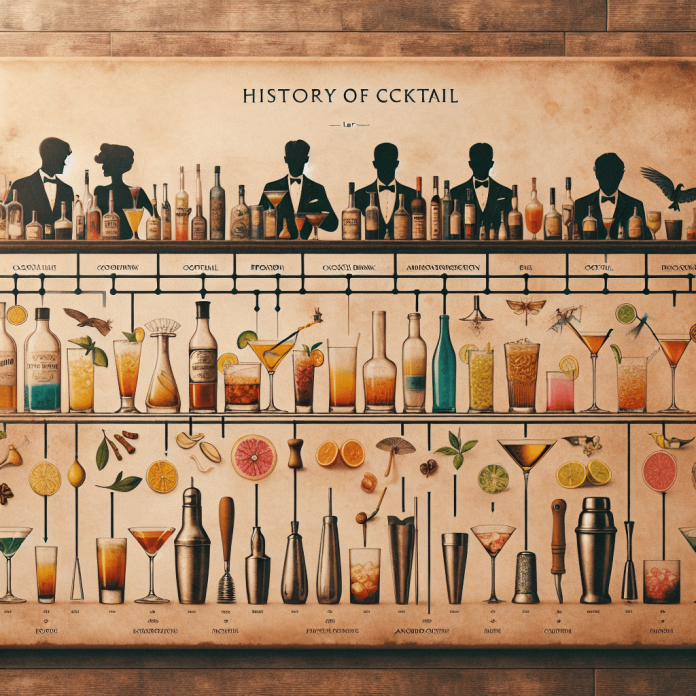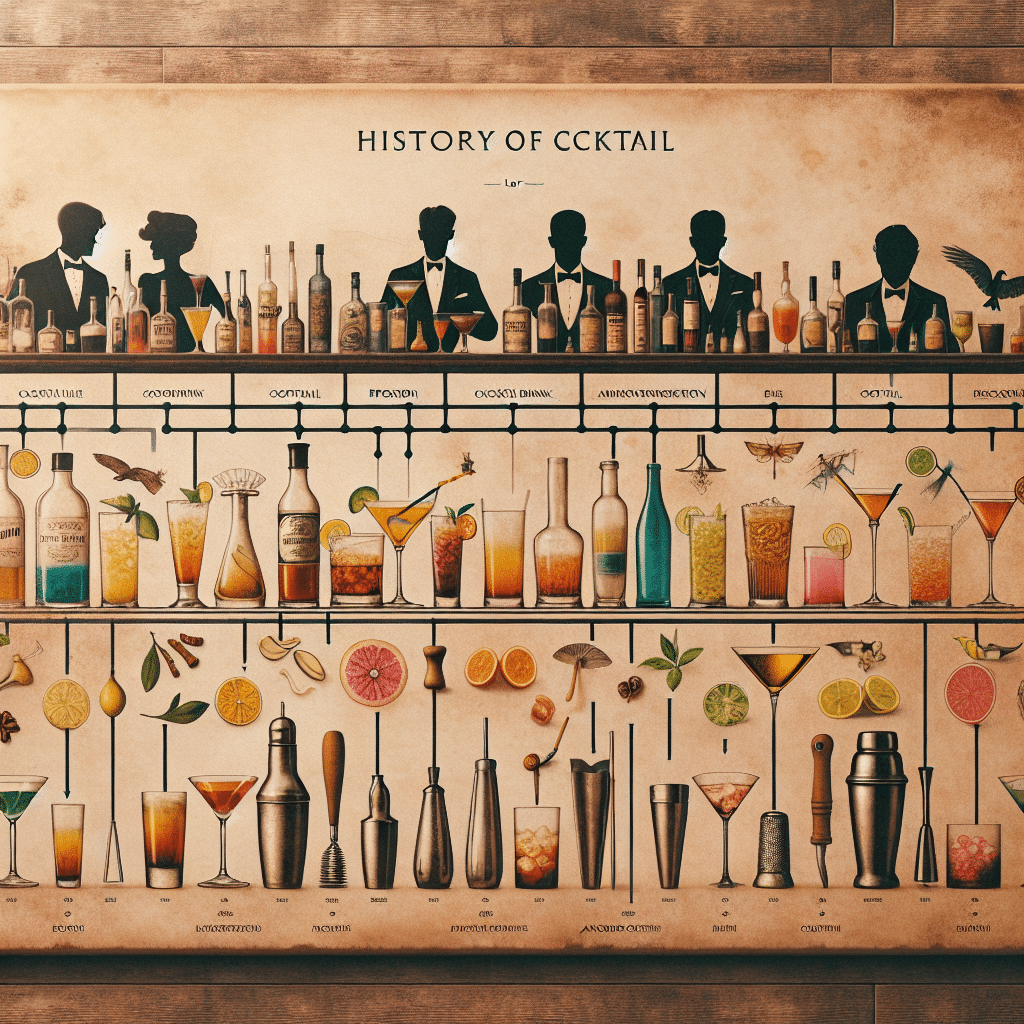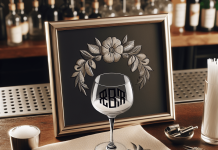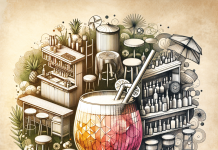In this article, we embark on a journey through time to uncover the fascinating origins of cocktails, the stories behind famous bartenders, and the intriguing lore that surrounds these beloved concoctions. From the classic martinis sipped by James Bond to the colorful creations served at trendy bars, we follow the evolution of cocktails, unearthing the secrets behind their creation and the masterminds who perfected the art of mixology. Join us as we peel back the layers of history and discover the enchanting world of cocktails.
Origins of Cocktails
Definition of a Cocktail
A cocktail is a mixed drink typically made with a combination of alcoholic and non-alcoholic ingredients. It is usually consumed for enjoyment and pleasure, often served in social gatherings or at bars and restaurants. Cocktails are known for their diverse flavors, creative presentations, and the skill required to mix them.
Early History of Cocktails
The history of cocktails can be traced back to ancient times. The ancient Greeks and Romans were known to mix wine with other ingredients, such as honey and herbs, to create unique and flavorful drinks. However, it was during the late 18th and early 19th centuries that cocktails as we know them today began to take shape.
Evolution of the Term ‘Cocktail’
The term ‘cocktail’ originally referred to a specific type of mixed drink. It is believed to have originated in the United States in the early 1800s. The exact etymology of the word is debated, but one popular theory suggests that it came from the French word “coquetier,” which means an eggcup. This theory suggests that early cocktails were served in small cups, similar to eggcups.
Early Types of Cocktails
During the early days of cocktails, several classic recipes emerged. These included slings and punch-style drinks, which were often made with a combination of spirits, sweeteners, and citrus. Juleps and cobblers were also popular, known for their refreshing qualities and fruit garnishes. The old fashioned cocktail, made with whiskey, sugar, bitters, and water, was another staple during this era. Gin and tonic and the martini also gained popularity during this time.
Famous Bartenders
Jerry Thomas – The Father of Mixology
Jerry Thomas, often referred to as the “Father of Mixology,” was a renowned bartender who lived during the 19th century. He gained fame for his exceptional skills in creating innovative and delicious cocktails. Jerry Thomas wrote the first-ever cocktail recipe book called “The Bartender’s Guide” in 1862, which became a landmark publication in the field of mixology.
Harry Craddock – The Savoy Cocktail Book
Harry Craddock was a legendary bartender who worked at The Savoy Hotel in London during the early 20th century. He was known for his creativity and ability to craft exquisite cocktails. Craddock’s most notable contribution to cocktail culture is “The Savoy Cocktail Book,” published in 1930. This book contains a collection of classic recipes and is considered a bible for aspiring bartenders.
Ernest Raymond Beaumont Gantt (Donn Beach) – Tiki Cocktail Pioneer
Ernest Raymond Beaumont Gantt, better known as Donn Beach, was a key figure in popularizing tiki cocktails in the mid-20th century. He opened the first tiki-themed bar, Don the Beachcomber, in Hollywood in 1934. Gantt’s elaborate tropical cocktails, featuring exotic flavors and imaginative presentations, became an instant hit. His influence on tiki culture and mixology is still celebrated today.
Dale DeGroff – The King of Cocktails
Dale DeGroff, also known as “King Cocktail,” is a world-renowned mixologist and bartender. He is credited with reviving the craft cocktail movement in the 1980s and elevating the profession of bartending to new heights. DeGroff’s expertise and passion for creating balanced and flavorful drinks have made him a respected figure in the cocktail industry.
Julio Bermejo – The Margarita Maestro
Julio Bermejo is an influential bartender and owner of Tommy’s Mexican Restaurant in San Francisco. He is hailed as the “Margarita Maestro” for his dedication to perfecting the classic Mexican cocktail. Bermejo’s version of the margarita, made with fresh lime juice, agave syrup, and high-quality tequila, has been widely recognized as one of the best in the world, earning him a well-deserved reputation in the cocktail community.
Cocktail Lore
Prohibition and Its Impact on Cocktails
Prohibition, which lasted from 1920 to 1933 in the United States, had a profound impact on the cocktail culture. With the ban on the production and sale of alcoholic beverages, people turned to the illicit trade of bootlegged spirits. Speakeasies, secret bars that operated during this time, became hotbeds for innovative cocktail creations. Prohibition gave rise to the popularity of cocktails, as they were often mixed with other ingredients to mask the taste of inferior quality alcohol.
The Birth of Tiki Culture
Tiki culture emerged in the 1930s and 1940s as a response to the growing fascination with Polynesian and Hawaiian themes. Donn Beach and his rival, Victor Bergeron (Trader Vic), played significant roles in popularizing this exotic and tropical aesthetic. Tiki bars, adorned with bamboo decor and serving elaborate rum-based cocktails, captivated the public’s imagination and became symbols of escapism and relaxation.
James Bond and the Vesper Cocktail
The fictional character James Bond, created by author Ian Fleming, has had a lasting impact on cocktail culture. In the novel “Casino Royale,” Bond famously orders a Vesper cocktail, made with gin, vodka, and Kina Lillet. This cocktail gained popularity and became synonymous with the suave and sophisticated image of Bond. The Vesper cocktail serves as a testament to the power of cocktails in popular culture.
Cocktails in Pop Culture
Cocktails have become an integral part of popular culture, often featured in movies, TV shows, and literature. From the classic martini in “Casablanca” to the cosmopolitan in “Sex and the City,” cocktails are frequently associated with memorable characters and iconic moments on the screen. Bartenders and mixologists have also gained celebrity status, showcasing their skills in competitions and reality TV shows.
Signature Cocktails of Iconic Bars
Many iconic bars around the world are known for their signature cocktails. These cocktails have become synonymous with the establishments and are often sought after by visitors. The Odeon’s cosmopolitan in New York City, Harry’s New York Bar’s French 75 in Paris, Raffles Hotel’s Singapore Sling, Caribe Hilton’s pina colada in Puerto Rico, and Caffè Giacosa’s negroni in Florence are just a few examples of signature cocktails that have become legendary in their respective locations.
Definition of a Cocktail
Original Definition
The original definition of a cocktail was a mixture of spirits, sugar, water, and bitters. This definition was coined by the editors of the periodical “Balance and Columbian Repository” in Hudson, New York, in 1806. The term ‘cocktail’ was used to describe a specific type of drink that was meant to stimulate the appetite and invigorate the senses.
Definition by the International Bartenders Association (IBA)
The International Bartenders Association (IBA) provides a more modern definition of a cocktail. According to the IBA, a cocktail is an alcoholic beverage made by combining one or more spirits with other ingredients, such as fruit juices, syrups, or bitters. The IBA has also established a list of “Official Cocktails” that represents the classic and most well-known cocktail recipes.
Early History of Cocktails
Origin of the Word ‘Cocktail’
The origin of the word ‘cocktail’ is still a subject of debate among historians and etymologists. One theory suggests that it derived from the French word “coquetel,” which referred to a type of horse with a tail cut short. The shortening of the tail was likened to the practice of cutting the end of a paper parasol to garnish a drink, leading to the association with mixed drinks.
Early Mentions of Cocktails in Literature
The earliest known mention of the word ‘cocktail’ in print can be found in “The Morning Post and Gazetteer” in London in 1798. The term appeared in an article discussing a racehorse named “The Cocktail.” This suggests that the term was already in use in certain circles, although its exact meaning at that time is not clear.
Cocktails in Early American Taverns and Saloons
During the early 19th century, American taverns and saloons were hubs of social activity where people gathered to enjoy drinks and conversation. Bartenders at these establishments honed their craft and experimented with various ingredients to create unique and flavorful cocktails. Punches, slings, and various mixed drinks became popular choices, setting the stage for the future of cocktails.
Evolution of the Term ‘Cocktail’
The Cocktail as a Morning Pick-Me-Up
In the early 19th century, cocktails were not limited to evening indulgence. They were often consumed as morning pick-me-ups or as a remedy for various ailments. These morning cocktails, known as “eye-openers,” were believed to provide a stimulating effect and help jumpstart the day. Over time, this practice evolved, and cocktails became more associated with socializing and leisure.
The Cocktail as a Style of Drink
By the mid-19th century, the cocktail had emerged as a distinct style of drink. It became associated with mixing spirits, sweeteners, and bitters in specific ratios to create a balanced and flavorful beverage. The cocktail gained popularity for its versatility and ability to showcase the unique qualities of different spirits and ingredients.
Controversies and Debates Surrounding the Term ‘Cocktail’
The exact definition and ingredients of a cocktail have been subjects of debate and controversy throughout history. Bartenders, mixologists, and cocktail enthusiasts have varying opinions on what constitutes a true cocktail. Some argue that a cocktail must contain a specific combination of spirits, while others believe that any mixed drink can be considered a cocktail. These debates continue to shape the ever-evolving world of cocktails.
Early Types of Cocktails
Sling and Punch-Style Cocktails
Slings and punch-style cocktails were early forms of mixed drinks that gained popularity in the 18th and 19th centuries. Slings were made by mixing spirits with sweeteners and citrus juices, often served over ice. Punches, on the other hand, were larger batch drinks made with a combination of spirits, fruit juices, sweeteners, and spices. These early cocktail styles laid the foundation for more complex and refined recipes.
Juleps and Cobblers
Juleps and cobblers were refreshing and elegant cocktails that gained popularity during the 19th century. Juleps were traditionally made with bourbon or brandy, sugar, and mint, served over crushed ice. Cobblers were fruit-based cocktails that often featured wine or sherry as a base, mixed with sugar, fruit slices, and ice. These drinks were popular choices for those seeking a light and flavorful cocktail.
The Old Fashioned Cocktail
The Old Fashioned cocktail is one of the oldest known cocktails and has remained a classic throughout history. It is traditionally made with whiskey, sugar, water, and bitters, stirred together and served over ice. The Old Fashioned exemplifies the simplicity and elegance of early cocktail culture, showcasing the rich flavors of the spirits and the subtle complexity of the ingredients.
The Gin and Tonic
The Gin and Tonic is a classic cocktail that emerged during the 19th century as a refreshing and medicinal drink. It was originally created as a way to consume quinine, a medication used to prevent malaria, which had a bitter taste. By mixing quinine with gin, water, and sweeteners, the resulting cocktail became a popular choice, especially among British colonists in tropical regions.
The Martini
The Martini is arguably one of the most iconic cocktails in history. It originated as a mixture of gin and vermouth, often garnished with an olive or lemon twist. The Martini has evolved over time, with variations that include vodka instead of gin and diverse additions such as fruit infusions or bitters. The Martini’s elegance and simplicity have solidified its place as a timeless cocktail.
Jerry Thomas – The Father of Mixology
Early Life and Career
Jerry Thomas was born in 1830 in New York and began his career as a bartender in the mid-19th century. Known for his showmanship and flair, Thomas quickly gained recognition for his ability to entertain and create exceptional cocktails. He worked at various bars and hotels throughout his career, including the famous Metropolitan Hotel in New York City.
The Bartender’s Guide – A Landmark Publication
In 1862, Jerry Thomas published “The Bartender’s Guide,” also known as “How to Mix Drinks or The Bon Vivant’s Companion.” This book was the first-ever cocktail recipe guide and became a seminal publication in the field of mixology. It featured recipes for over 230 cocktails, along with anecdotes and advice for aspiring bartenders. Thomas’ book solidified his reputation as the “Father of Mixology.”
Notable Cocktails by Jerry Thomas
Jerry Thomas was known for his creativity and innovation in cocktail creation. Some of his most notable creations include the Blue Blazer, a spectacle of flaming whiskey poured between two glasses, and the Improved Whiskey Cocktail, a refined version of the Old Fashioned cocktail. Thomas’ recipes and techniques continue to inspire bartenders around the world, allowing his legacy to live on.
Harry Craddock – The Savoy Cocktail Book
Life and Work at The Savoy Hotel
Harry Craddock was an English bartender who worked at The Savoy Hotel in London during the early 20th century. He brought his expertise to The Savoy, quickly gaining a reputation for his exceptional cocktails and impeccable service. Craddock’s career flourished during the era of Prohibition in the United States, as many American visitors sought refuge in London and gravitated towards The Savoy’s cocktail bar.
The Iconic Savoy Cocktail Book
In 1930, Harry Craddock compiled and published “The Savoy Cocktail Book,” which became a classic in the world of mixology. The book contains a comprehensive collection of recipes for over 750 cocktails, categorized by spirit and type. It also includes illustrations and stories, capturing the charm and elegance of The Savoy Hotel during its illustrious era. The Savoy Cocktail Book remains a definitive reference for cocktail enthusiasts and professionals alike.
Influence on Modern Mixology
Harry Craddock’s contributions to cocktail culture extended beyond his role at The Savoy. His emphasis on quality ingredients, attention to detail, and dedication to service set a standard for modern mixology. The Savoy Cocktail Book served as a source of inspiration for countless bartenders, and its recipes continue to be used and adapted in contemporary cocktail menus worldwide.
Signature Cocktails of Iconic Bars
The Cosmopolitan at The Odeon
The Odeon, located in New York City’s Tribeca neighborhood, is known for its iconic Cosmopolitan cocktail. This vibrant pink drink, made with vodka, cranberry juice, triple sec, and freshly squeezed lime juice, gained widespread popularity in the 1990s due to its appearance on the TV show “Sex and the City.” The Cosmopolitan remains a symbol of New York City’s cocktail scene and is often associated with chic and sophisticated settings.
The French 75 at Harry’s New York Bar
Harry’s New York Bar, located in Paris, is a historic establishment that has been serving cocktails since 1911. One of their signature drinks is the French 75, a refreshing combination of gin, lemon juice, sugar, and champagne. The French 75 is believed to have originated during World War I, named after the French artillery piece known for its kick. This iconic cocktail exemplifies the elegance and allure of Harry’s New York Bar.
The Singapore Sling at Raffles Hotel
Raffles Hotel in Singapore is home to one of the most famous cocktails, the Singapore Sling. Created in the early 20th century by bartender Ngiam Tong Boon, the Singapore Sling is a fruity and tropical drink made with gin, cherry brandy, Benedictine, lime juice, pineapple juice, and grenadine. This cocktail has become synonymous with Raffles Hotel and is a must-try for visitors to Singapore.
The Piña Colada at Caribe Hilton
Caribe Hilton in Puerto Rico claims to be the birthplace of the Piña Colada, a delightful combination of rum, pineapple juice, and coconut cream. Created in the 1950s by bartender Ramón “Monchito” Marrero, this tropical cocktail has since become an international favorite. Caribe Hilton’s Piña Colada holds a special place in cocktail history, representing the essence of Caribbean flavors and vacation vibes.
The Negroni at Caffè Giacosa
Caffè Giacosa, located in Florence, Italy, is famous for its Negroni cocktail. The Negroni is made with equal parts gin, Campari, and sweet vermouth, garnished with an orange twist. It is said to have been invented in the early 20th century by Count Camillo Negroni, who asked his bartender to strengthen his usual Americano cocktail by adding gin. Caffè Giacosa’s version of the Negroni remains one of the best in the world and has become a symbol of Italian craftsmanship and style.
In conclusion, the origins of cocktails can be traced back to ancient times, but it was during the 18th and 19th centuries that cocktails began to take shape as we know them today. Famous bartenders like Jerry Thomas, Harry Craddock, Ernest Raymond Beaumont Gantt, Dale DeGroff, and Julio Bermejo have played pivotal roles in shaping cocktail culture through their creativity and innovation. Prohibition, the birth of tiki culture, and the influence of popular culture have also significantly impacted the world of cocktails. Signature cocktails of iconic bars have become symbols of their establishments and destinations. The ongoing debates and controversies surrounding the definition and ingredients of a cocktail reflect the ever-evolving nature of mixology. Whether enjoying a classic Old Fashioned or sipping on the latest craft creation, cocktails continue to capture the imagination and delight our taste buds, making them an essential part of our social experiences. Cheers!









































